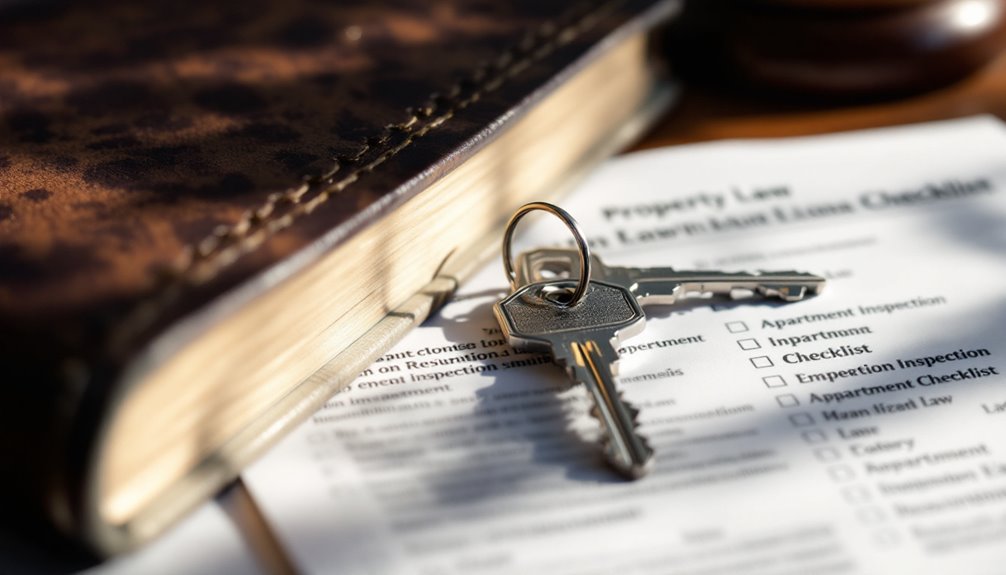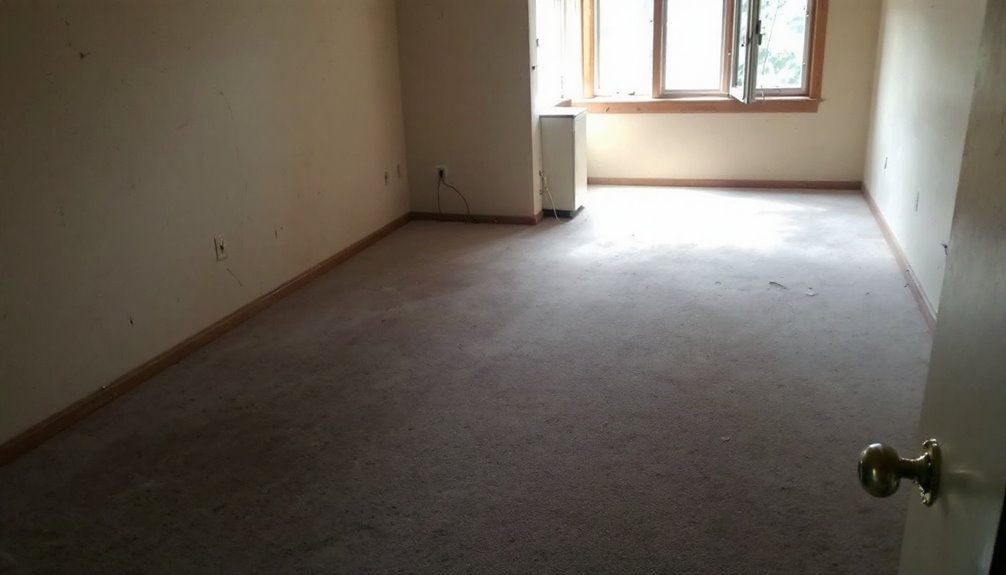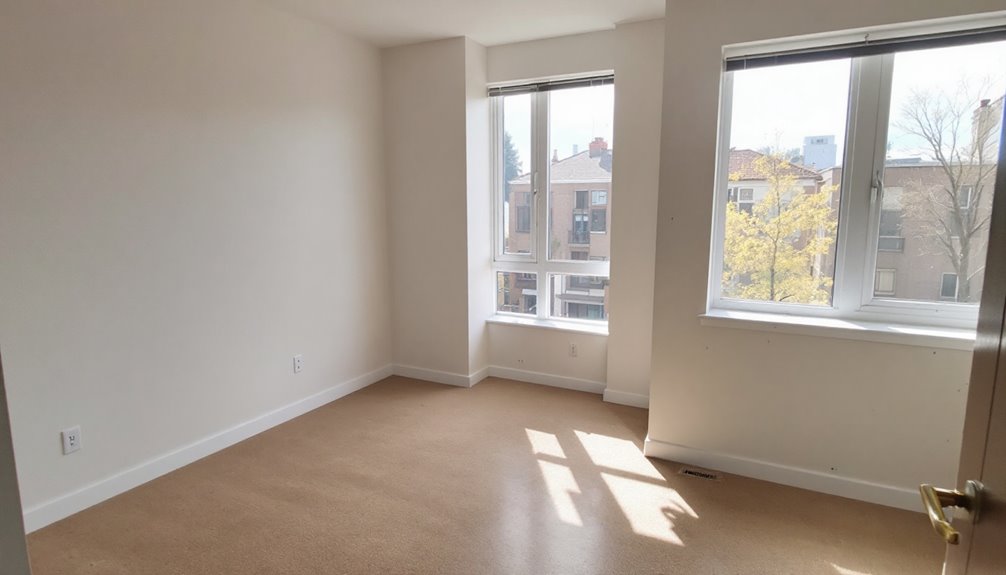Getting a security deposit back requires careful documentation and knowledge of tenant rights. Tenants should thoroughly photograph and document the property's condition before moving out, conduct a detailed move-out inspection, and maintain copies of all records. If a landlord refuses to return the deposit, tenants can send a formal demand letter citing state laws and timelines. When necessary, small claims court provides an effective path to recover wrongfully withheld deposits. Understanding the key steps and legal processes empowers tenants to protect their rights.
Key Takeaways
- Document the property's condition thoroughly with photos, videos, and written notes before moving out to establish proof of its state.
- Follow proper move-out procedures, including completing a walkthrough inspection with your landlord and addressing any concerns immediately.
- Send a formal written demand letter citing relevant state laws if your landlord fails to return the deposit within legal timeframes.
- Keep copies of all correspondence, maintain proof of providing your forwarding address, and track important deadlines for deposit returns.
- File a small claims court lawsuit as a last resort, gathering all evidence and documentation to support your case.
Understanding Your Legal Rights for Security Deposit Returns

A tenant's security deposit rights are protected by specific legal timeframes and requirements in New York State. Under landlord-tenant law, landlords must return security deposits within 14 days after the tenant moves out. This timeframe, established by the Housing Stability and Tenant Protection Act of 2019, also requires landlords to provide an itemized statement detailing any deductions.
Understanding legal rights regarding security deposit returns is vital. If landlords fail to comply with the 14-day deadline or don't provide an itemized statement, they forfeit their right to keep any portion of the deposit. For leases predating July 2019, landlords had a "reasonable time" (typically 30 days) to return deposits. Tenants can seek double damages in court if landlords willfully violate these requirements, making it essential to document all rental conditions and communications.
Essential Documentation Before Moving Out
Tenants should document every detail of their rental property's condition through thorough photos and videos before moving out. Room-by-room documentation serves as essential evidence of the unit's state, capturing everything from walls and floors to appliances and fixtures. This visual record, combined with detailed written notes about existing damage or wear, creates a strong foundation for recovering the security deposit and protecting against unfair deductions.
Record Every Property Detail
Documenting every detail of a rental property serves as crucial protection for both landlords and renters during the move-out process. A thorough record of every property detail approach requires creating exhaustive checklists for each room, documenting all existing conditions with photos and written notes. This security deposit documentation should include the state of walls, floors, appliances, fixtures, and any pre-existing damage.
Renters should coordinate a landlord inspection, inviting them to participate in the documentation process. If the landlord cannot attend, sharing detailed findings via email establishes a clear paper trail. Multiple copies of all records should be maintained, including timestamped photographs and written observations. This systematic approach creates a solid foundation for recovering the security deposit and prevents potential disputes over property conditions during move-out.
Take Clear Photo Evidence
When securing the return of a security deposit, clear photographic evidence serves as the strongest form of documentation. By thoroughly documenting property condition before move-in and after move-out, tenants create a solid foundation for disputing deductions if necessary. Photos and videos with time-date stamps provide irrefutable proof of the property's state during the final inspection.
- Capture detailed images of every room, including walls, floors, appliances, and fixtures
- Take close-up shots of any existing damage or wear
- Record video walkthroughs with continuous footage of all spaces
To maximize the effectiveness of photo documentation, tenants should email copies to their landlord immediately and retain backups in multiple locations. This evidence becomes essential when challenging unfair deductions and demonstrates a commitment to maintaining the property's condition throughout the tenancy.
The Move-Out Inspection Process

The move-out inspection marks a critical step in ending a rental agreement and securing the return of a security deposit. During this process, landlords and tenants conduct a thorough walkthrough of the property together, using a detailed checklist to compare current conditions with the initial move-in state.
Both parties should document each room's condition with photos and notes, identifying any damages beyond normal wear and tear. This careful documentation helps prevent landlord-tenant disputes and provides clear evidence if disagreements arise later. The inspection typically covers walls, floors, fixtures, appliances, and outdoor spaces.
To maximize the chances of a full security deposit return, tenants should attend the inspection in person, taking their own photos and immediately addressing any concerns raised by the landlord. Clear communication during this process helps establish expectations for both parties.
Normal Wear and Tear vs. Actual Damage
Tenants should understand the key differences between normal wear and tear versus actual damage when seeking their security deposit return. Common maintenance signs like faded paint, worn carpets, and small nail holes typically fall under normal wear and tear that landlords cannot deduct from deposits. Documenting pre-existing issues through photos and written records at move-in helps tenants prove which conditions existed before their occupancy and protects them from unfair deductions.
Common Maintenance Signs
Distinguishing between normal wear and tear versus actual property damage stands as a crucial factor in security deposit disputes. When evaluating landlord deductions, tenants should understand common maintenance signs that occur naturally over time.
Key indicators of normal wear and tear include:
- Paint-related issues like fading, minor peeling, or hairline cracks
- Floor wear patterns, including light scratches on hardwood or carpet paths
- Minor fixture aging, such as slight discoloration of bathroom surfaces or loose handles
The length of tenancy substantially impacts what qualifies as normal deterioration. For example, after four years, wooden surfaces typically show minor scratches, while paint loses its original luster. Understanding these patterns helps tenants challenge unfair security deposit return claims and confirms that landlords only deduct for genuine damage beyond expected aging.
Documenting Pre-Existing Issues
Proper documentation serves as a critical shield when protecting a security deposit from unfair deductions. When documenting pre-existing issues, tenants should thoroughly photograph and video each room, creating detailed records of any existing damage or maintenance concerns before moving in. This evidence becomes essential during potential property disputes later.
Understanding the difference between normal wear and tear versus actual damage helps prevent misunderstandings. While faded paint and minor scuffs are typically considered normal wear, broken appliances and large wall holes fall under property damage. Legal advice often emphasizes the importance of maintaining written communication with landlords about these conditions. Tenants should request an initial walkthrough inspection, carefully review the property condition report, and keep copies of all documentation, including time-stamped photos and correspondence with property management.
Writing an Effective Demand Letter

A well-crafted demand letter serves as the first formal step in recovering a security deposit from a landlord. The letter should clearly state the request for the security deposit return while maintaining a professional tone that signals the tenant's willingness to pursue legal action if necessary.
Three essential components of an effective demand letter include:
- Detailed information about the rental property, tenancy dates, and security deposit amount
- Documentation of the property's condition at move-out, including photos and inspection reports
- Clear deadline for response and consequences if the landlord fails to comply
The letter should be sent via certified mail with return receipt requested, providing proof of delivery. Including relevant lease clauses and state laws regarding security deposit regulations strengthens the tenant's position and demonstrates knowledge of their legal rights.
State-Specific Security Deposit Laws
State-by-state rules shape every aspect of security deposit management, from maximum amounts landlords can charge to deadlines for returning funds. Maximum deposit limits vary substantially, with Alabama allowing up to one month's rent, while Alaska permits up to two months' rent for properties under $2,000 monthly.
Return deadlines also differ by location. Hawaii requires landlords to return deposits within 14 days after lease termination, while Oregon allows 31 days. State-specific security deposit laws often mandate interest payments under certain conditions. Alaska requires interest on deposits held over two years, while Illinois focuses on Chicago properties held beyond six months. Michigan mandates interest for deposits kept longer than six months, and Minnesota requires annual interest payments. Understanding these regional variations helps tenants protect their rights when seeking deposit returns.
Common Reasons Landlords Withhold Deposits

Landlords commonly withhold security deposits for four main reasons: property damage, unpaid rent and utilities, cleaning costs, and lease violations. Understanding these common deductions helps tenants protect their deposits and handle disputes effectively.
Key situations that justify deposit deductions include:
- Significant property damage like broken windows, large holes, or damaged appliances
- Unpaid rent, utility bills, or accumulated late fees
- Extensive cleaning needs beyond normal wear and tear
Normal wear and tear, such as minor nail holes or faded paint, should not result in deductions. However, landlords can withhold deposits for carpet stains, broken fixtures, or pet damage in non-pet-friendly units. To support deductions, landlords must provide itemized statements detailing all costs and include relevant documentation or receipts.
Steps to Take When Your Landlord Refuses to Pay
When a landlord refuses to return a security deposit, tenants must take specific actions to protect their rights and recover their money. The first step is requesting a written statement detailing any damages and deductions within the 30-day period. If the landlord fails to provide this documentation, they risk forfeiture of their right to withhold any portion of the deposit. If the landlord does not respond or refuses to return the deposit without justification, the tenant can send a formal demand letter requesting payment. If this step does not resolve the issue, the tenant may need to take legal action in small claims court to recover the withheld funds. During this process, many tenants may wonder, can a landlord evict you for pursuing legal action?
Tenants should document the property's condition through photos and videos, maintain all correspondence, and verify they've provided a forwarding address. If the landlord still refuses to comply, sending a formal demand letter is essential before pursuing legal action. Tenants can then file a lawsuit in civil court, potentially recovering double the deposit amount plus additional damages. Working with a housing advocacy group or attorney can strengthen the case and guarantee compliance with local laws.
Small Claims Court Filing Process

Small claims court provides tenants with a straightforward legal avenue to recover their security deposits without hiring an attorney. When filing a landlord dispute over a security deposit, tenants must complete specific steps and forms in their local court.
Key steps for filing in small claims court include:
- File form SC-100 (Plaintiff's Claim) in the correct county, including detailed information about the dispute and the amount sought
- Pay the required court filing fee, typically around $80, or request a fee waiver if eligible
- Arrange for proper service of the lawsuit to the landlord and submit proof of service to the court
Most small claims courts offer free mediation services after filing, which can help resolve security deposit disputes before the formal hearing. Evidence preparation and organization are vital for presenting a strong case.
Calculating Interest on Your Security Deposit
Money sitting in a security deposit account doesn't just gather dust – it earns interest over time. Calculating interest involves a simple formula: Principal × Rate × Time. However, state-specific requirements vary substantially. Minnesota mandates 1% annual interest, while Connecticut bases rates on commercial bank savings accounts.
To guarantee accurate calculations, proper documentation and record keeping are essential. Tenants should maintain initial deposit receipts, annual interest statements, and records of all landlord communications. Some states have additional requirements, such as New Jersey's mandate for landlords with 10+ units to invest deposits in insured accounts, paying interest quarterly or annually. Others, like Ohio, only require interest payments for deposits held longer than six months at a 5% annual rate.
Tips for Preventing Deposit Disputes

Clear steps taken before and during a tenancy can prevent most security deposit disputes from arising in the first place. By following proven preventive measures, tenants can substantially increase their chances of a timely return of their deposit.
- Document everything thoroughly with dated photos and videos of the property's condition before moving in furniture, and have the landlord sign off on the inventory checklist
- Register with a deposit protection scheme immediately and verify the landlord has provided scheme details within 30 days
- Address maintenance issues promptly, report problems in writing, and keep copies of all communications with the landlord
These proactive steps create a clear paper trail and establish expectations from the start. If disputes do arise, having proper documentation makes the dispute resolution process much smoother and increases the likelihood of a favorable outcome.
Working With Roommates to Recover Deposits
During situations with multiple tenants, recovering a security deposit requires careful coordination and clear communication between roommates. Under joint and several liability, all tenants share responsibility for the full deposit amount, regardless of individual contributions.
When lease termination occurs, roommates should understand that the deposit remains with the property until all tenants vacate. For situations where one roommate leaves early, creating a written agreement between roommates can help manage deposit transfers and responsibilities. This agreement should outline how the departing tenant's share will be handled, whether through direct reimbursement from remaining tenants or contributions from new ones.
For dispute resolution, tenants should document all arrangements and maintain clear records, as landlords typically issue one refund check to all tenants listed on the lease rather than separate payments.
Frequently Asked Questions
Can My Landlord Keep My Deposit if I Break the Lease Early?
Landlords can legally keep a security deposit if a tenant breaks the lease early, but specific conditions must be met. The lease should include clear termination clauses, and state laws regulate what landlords can deduct. They can use the deposit to cover unpaid rent, damages, and re-renting costs until a new tenant is found. However, many states require landlords to make reasonable efforts to re-rent the property quickly.
What Happens to My Security Deposit if My Landlord Sells the Property?
Picture a baton being passed in a relay race – that's how a security deposit should transfer when a property is sold. The original landlord must transfer the deposit to the new owner and provide written confirmation to the tenant. The new owner becomes fully responsible for the deposit and must honor the existing lease terms. If this transfer isn't handled properly, tenants have legal rights to pursue the return of their deposit.
Can Landlords Charge Cleaning Fees Even if I Professionally Cleaned the Unit?
Yes, landlords can charge cleaning fees even after professional cleaning if the cleaning doesn't meet required standards. The key is whether the unit has been restored to its original condition, beyond normal wear and tear. To justify charges, landlords must document the property's condition and provide itemized deductions. However, any cleaning fees must be reasonable and comparable to local market rates, typically between $50-100 per hour.
How Does Bankruptcy of Either Landlord or Tenant Affect Security Deposit Returns?
As the old saying goes, "possession is nine-tenths of the law," but bankruptcy complicates security deposit returns substantially. When landlords declare bankruptcy, tenants become unsecured creditors unless the deposit was held in trust, making recovery challenging. Conversely, if tenants file for bankruptcy, their security deposit becomes part of their bankruptcy estate, and landlords need court approval to use it. State laws and lease terms play vital roles in determining the outcome.
Can My Landlord Use My Security Deposit for Repairs During My Tenancy?
No, landlords cannot use a security deposit for repairs during an active tenancy. The security deposit can only be used after the rental agreement ends and the tenant moves out. During the tenancy, landlords are responsible for coordinating and paying for necessary repairs directly. They must wait until lease termination to make any deductions, and then only for unpaid rent or damages beyond normal wear and tear.
Conclusion
Studies show that over 26% of renters never receive their security deposits back, amounting to billions in unreturned funds annually. However, tenants who understand their rights and follow proper documentation procedures are three times more likely to recover their deposits. By taking proactive steps, maintaining thorough records, and knowing when to pursue legal action, renters can effectively challenge unfair deposit withholding and protect their financial interests.
